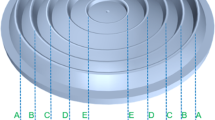Abstract
Investigation of the geometric and optical quality of polymer lenses in the injection molding process is costly and time-consuming. So, reducing the cost of inspection while ensuring the optical quality of the lenses after production is considered in this study. The geometric quality of bi-convex and bi-concave spherical lenses is achieved by monitoring the pressure and temperature profile inside the mold cavity during injection. Regarding the priority of the effect of the geometric parameters, average volumetric shrinkage and warpage are the best parameters for consideration. The results show that the most important effective injection molding process parameters in lens molding are packing time, packing pressure, melt temperature and mold temperature. According to the experimental results, the average amounts of PV for the two surfaces of the bi-convex lens in the optimum level are 7.7 μ and 7.9 μ and for the bi-concave lens are 8.8 μ and 8.1 μ. In addition, the geometric quality of a lens is better when the trend of slope of the pressure graph is lowered to zero and should not be reduced suddenly for all three sensors locations.


































Similar content being viewed by others
References
Sortino M, Totis G, Kuljanic E (2014) Comparison of injection molding technologies for the production of micro-optical devices. Procedia Eng 69:1296–1305. https://doi.org/10.1016/j.proeng.2014.03.122
Young W-B (2005) Effect of process parameters on injection compression molding of pickup lens. Appl Math Model 29(10):955–971. https://doi.org/10.1016/j.apm.2005.02.004
Tsai K-M (2013) Runner design to improve quality of plastic optical lens. Int J Adv Manuf Technol 66(1):523–536. https://doi.org/10.1007/s00170-012-4346-2
Lee YB, Kwon TH (2001) Modeling and numerical simulation of residual stresses and birefringence in injection molded center-gated disks. J Mater Process Technol 111(1):214–218. https://doi.org/10.1016/S0924-0136(01)00524-6
Kwak TS, Suzuki T, Bae WB, Uehara Y, Ohmori H (2005) Application of neural network and computer simulation to improve surface profile of injection molding optic lens. J Mater Process Technol 170(1):24–31. https://doi.org/10.1016/j.jmatprotec.2005.04.099
Tsai K-M, Hsieh C-Y, Lo W-C (2009) A study of the effects of process parameters for injection molding on surface quality of optical lenses. J Mater Process Technol 209(7):3469–3477. https://doi.org/10.1016/j.jmatprotec.2008.08.006
Lu X, Khim LS (2001) A statistical experimental study of the injection molding of optical lenses. J Mater Process Technol 113(1):189–195. https://doi.org/10.1016/S0924-0136(01)00606-9
Spina R, Walach P, Schild J, Hopmann C (2012) Analysis of lens manufacturing with injection molding. Int J Precis Eng Manuf 13(11):2087–2095. https://doi.org/10.1007/s12541-012-0276-z
Tsai K-M, Lan J-K (2015) Correlation between runner pressure and cavity pressure within injection mold. Int J Adv Manuf Technol 79(1):273–284. https://doi.org/10.1007/s00170-014-6776-5
Tsai K-M, Luo H-J (2017) An inverse model for injection molding of optical lens using artificial neural network coupled with genetic algorithm. J Intell Manuf 28(2):473–487. https://doi.org/10.1007/s10845-014-0999-z
Tsai K-M, Tang B-H (2014) Determination of injection molding process window based on form accuracy of lens using response surface methodology. Int J Adv Manuf Technol 75(5):947–958. https://doi.org/10.1007/s00170-014-6185-9
Montgomery DC (2012) Design and analysis of experiments, 8th edn. Wiley, London. ISBN: 978-1-118-14692-7
Moayyedian M, Abhary K, Marian R (2018) Optimization of injection molding process based on fuzzy quality evaluation and Taguchi experimental design. CIRP J Manuf Sci Technol. https://doi.org/10.1016/j.cirpj.2017.12.001
LTD SCSP (2007) Sumipex (acrilic molding resin). Singapore
© 2015 Autodesk I (2016) Autodesk Moldflow Insight/Synergy 2016
Bäumer S (2010) Handbook of plastic optics. Wiley-VCH Verlag GmbH & Co. KGaA, Weinheim
Cellere A, Lucchetta G (2010) Identification of Crims model parameters for warpage prediction in injection moulding simulation. Int J Mater Form 3(1):37–40. https://doi.org/10.1007/s12289-010-0701-8
ISO10110 (2014) Optics and photonics, preparation of drawings for optical elements and systems. Part 5: surface form tolerances. International Organization for Standardization, Geneva
Schaub MP (2009) The design of plastic optical systems. SPIE, Bellingham. https://doi.org/10.1117/3.796330
Kazmer DO, Velusamy S, Westerdale S, Johnston S, Gao RX (2010) A comparison of seven filling to packing switchover methods for injection molding. Polym Eng Sci 50(10):2031–2043. https://doi.org/10.1002/pen.21731
Pramujati B, Dubay R, Samaan C (2006) Cavity pressure control during cooling in plastic injection molding. Adv Polym Technol 25(3):170–181. https://doi.org/10.1002/adv.20068
Zhou X, Zhang Y, Mao T, Zhou H (2017) Monitoring and dynamic control of quality stability for injection molding process. J Mater Process Technol 249:358–366. https://doi.org/10.1016/j.jmatprotec.2017.05.038
Hassan H (2013) An experimental work on the effect of injection molding parameters on the cavity pressure and product weight. Int J Adv Manuf Technol 67(1):675–686. https://doi.org/10.1007/s00170-012-4514-4
Chen X, Chen G, Gao F (2004) Capacitive transducer for in-mold monitoring of injection molding. Polym Eng Sci 44(8):1571–1578. https://doi.org/10.1002/pen.20154
Osswald TA, Menges G (2012) Material science of polymers for engineers, 3rd edn. Hanser, Munich, pp I–XIX. https://doi.org/10.3139/9781569905241.fm
Acknowledgements
Special thanks to Professor Mahmoud Masoumi, the faculty of Chemical Engineering Department, and Professor Mehdi Ranjbar, the faculty of Physics Department for their valuable comments. Also thanks to the staff of the Polymer and Glass Processing laboratory in the Mechanical Engineering Department, Isfahan University of Technology.
Author information
Authors and Affiliations
Corresponding author
Additional information
Technical Editor: Márcio Bacci da Silva, Ph.D.
Rights and permissions
About this article
Cite this article
Barghikar, H., Mosaddegh, P. Experimental and simulation study on the optimum of the geometrical quality of bi-convex and bi-concave lenses produced by injection molding process. J Braz. Soc. Mech. Sci. Eng. 41, 24 (2019). https://doi.org/10.1007/s40430-018-1530-9
Received:
Accepted:
Published:
DOI: https://doi.org/10.1007/s40430-018-1530-9




